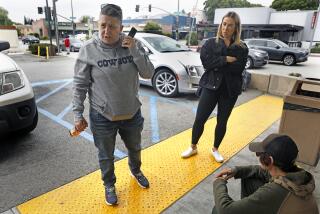Phone Line Is Place Lonely Children Find Connection
- Share via
Estimates indicate that as many as one out of every three children in the United States is home alone after school. Based on these statistics, at least 15,000 children attending schools in Glendale, Pasadena and Burbank come home from school every day to an empty house.
Thanks to the Community Services office at Glendale Adventist Medical Center, a friend for these often lonely or bored children is just a telephone call away.
Phonefriend is a talk line for children who attend the 50 elementary schools in the three communities. The youngsters often need just a friendly, reassuring voice.
“We don’t like to call them latchkey kids,” said Bruce Nelson, volunteer services director for the medical center. “We call them home-alones instead, because it’s not negative. Phonefriend isn’t a crisis-oriented program. Rather, it’s a warm line, in which our counselors get just as much as the children do from the conversation.”
The Phonefriend concept was developed by the American Assn. of University Women chapter at Pennsylvania State University.
Glendale Adventist Medical Center volunteer Richard Roberts discovered it while doing research in the hospital library.
“We were already involved in the Baby Cuddler Program, in which drug-addicted infants who get zero attention get cuddled and loved by volunteers on a regular basis. So, we thought, ‘What’s the next step to help children?’ And I discovered the Phonefriend program was in place at Southwest General Hospital in Middleburg, Ohio. And we worked with them to establish a similar program here,” he said.
Phonefriend started last year, but until now it only served Glendale schoolchildren.
More than 50,000 colorful flyers are being distributed at elementary schools in the three cities, announcing the number that children can call between 3 and 5 p.m. on school days to find a friend.
Ziggy, the often bemused, bewildered and lonely comic strip character, serves as the official Phonefriend mascot. In the flyer, for example, Ziggy encourages home-alone children to call if they feel like talking or have a question or problem to discuss.
Three phone banks in the community services office at the medical center are staffed by trained counselors every school day afternoon.
“Counselors are encouraged not to rescue children or solve their problems, but to simply listen with care and concern,” Nelson said. “We encourage that they respect the child’s individuality, be supportive of the child and help the child discover his or her own resources as needed.”
Child psychologist Alan Sandler, medical director of the child in-patient unit of Pine Grove Hospital in Canoga Park, sees the issue of home-alones in the 1990s as one “beginning to transcend all social classes.”
“It would be nice if children didn’t have to be on their own after school. In children who are adaptable, less vulnerable and sensitive, there are social benefits of being in a home environment that requires them to be more independent: “They learn mastery of certain situations.”
But, he said, “It’s the less adaptable kids who get into difficulty. For those less able to tolerate loneliness and anxiety, it’s nice to have someone with whom they can check in.”
Richard Roberts recalls the time a 7-year-old girl called Phonefriend, troubled that she had fallen and bruised her arm on the way home from school.
“We reviewed what remedies she had taken, and she was concerned because her arm still hurt. I assured her she had done the right thing, assured her that it would hurt for a while, and asked her to make sure that she told her mother what had happened as soon as she got home. By the end of the conversation, she was feeling good, and that made me feel good too.”
All counselors are trained to encourage the children to confide in their parents about all problems. “Teachers in the school system are our biggest boosters, but we also want the parents to be informed about Phonefriend,” Nelson said. “We make it clear in all our literature and discussions that we’re not there to take the parents’ place.”
Former teacher and preschool director Dorothea Ryan of Redondo Beach was already a volunteer at the medical center when she heard of Phonefriend and became intrigued with the program.
“You really get a satisfaction from doing it. It’s really interesting to draw the children out and get them to talk about their school and activities. They have some really interesting stories to tell!” she said.
In fact, most of the 20 or more calls daily coming through on Phonefriend lines don’t involve problems at all. “One of the favorite caller-counselor interactions is sharing jokes,” Nelson said. “In fact, if a child doesn’t know a joke, they often call back with a joke to share the next day.”
Nelson chuckled as he told one of the Phonefriend line’s favorite jokes: “What do you get when you cross Lassie with a pit bull terrier? A dog who bites your leg and then runs for help!”
“Well,” he added, “you can see by the tenor of this joke that the kids aren’t all sugar and spice. Some of them are pretty sophisticated.”
Because the program promises confidentiality, only first names of both caller and counselor are used. Each counselor does, however, keep a record of the child’s name, age and purpose of call in a log book, should any follow up be needed.
Calls average between two and three minutes, but children in emotional pain often talk longer. To help a child avoid becoming dependent upon the counselor or the Phonefriend service, children who demonstrate dependency are gently encouraged after a few minutes of conversation to call again the next day so that the lines are not tied up for any length of time by just one caller.
“We’ve had kids as young as 4 and as old as 17 call Phonefriend; not everybody who calls is a home-alone kid. We even get parents calling to check to see that the line is really toll-free,” Nelson said.
He expressed surprise that more Phonefriend programs haven’t sprung up throughout the state.
“More often than not it’s the good news that kids want to share with you; they can’t wait until Mom or Dad gets home to hear about the good grade, or hear them sing a song they learned at school. Or sometimes they want someone to hear about their vacation. Only one out of every 200 calls is really a crisis situation.”
Nelson and Roberts have spread word of the program by speaking to such groups as the Parent Teacher Assn. and the Glendale Police Department. Because children were calling 911 with calls that were not emergencies, police asked 911 operators to refer them to Phonefriend instead.
Nelson said he is always on the lookout for volunteer applicants because “it takes a special kind of person. You have to be a good listener. Obviously, we need someone who likes children.”
Counselors receive training and are asked to make a commitment to work two hours a week for at least six months.
More to Read
Sign up for Essential California
The most important California stories and recommendations in your inbox every morning.
You may occasionally receive promotional content from the Los Angeles Times.













